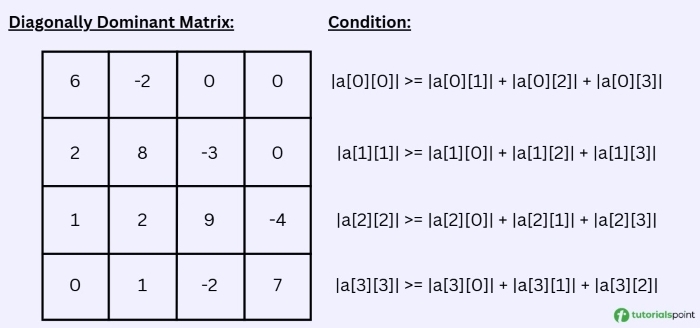
 Data Structure
Data Structure Networking
Networking RDBMS
RDBMS Operating System
Operating System Java
Java MS Excel
MS Excel iOS
iOS HTML
HTML CSS
CSS Android
Android Python
Python C Programming
C Programming C++
C++ C#
C# MongoDB
MongoDB MySQL
MySQL Javascript
Javascript PHP
PHP
- Selected Reading
- UPSC IAS Exams Notes
- Developer's Best Practices
- Questions and Answers
- Effective Resume Writing
- HR Interview Questions
- Computer Glossary
- Who is Who
JavaScript Program for Diagonally Dominant Matrix
Diagonally dominant matrix refers to square matrix having magnitude of diagonal element in a row greater than or equal to the sum of magnitude of non-diagonal elements in that row.
In this article we are having a square matrix, our task is to write JavaScript program for diagonally dominant matrix. Users must be familiar with 2D matrix, nested for loop and conditional statement.

Formula:
$$\mathrm{|\:a_{ii}\:|\:\geq\:\displaystyle\sum\limits_{j ? i}\:|\:a_{ij}|}$$
for all i Where aij denotes the entry in the ith row and jth columnExample
Input:
[A] =
[[6, -2, 0, 0],
[2, 8, -3, 0],
[1, 2, 9, -4],
[0, 1, -2, 7]]
Condition for Diagonally Dominant Matrix :
|a[i][i]| >= |a[i][j1]| + |a[i][j2]| + .... |a[i][jn]|
for i = 0,
|a[0][0]| >= |a[0][1]| + |a[0][2]| + |a[0][3]|
|6| >= |-2| + |0| + |0|
for i = 1,
|a[1][1]| >= |a[1][0]| + |a[1][2]| + |a[1][3]|
|8| >= |-2| + |-3| + |0|
for i = 2,
|a[2][2]| >= |a[2][0]| + |a[2][1]| + |a[2][3]|
|9| >= |1| + |2| + |-4|
for i = 3,
|a[3][3]| >= |a[3][0]| + |a[3][1]| + |a[3][2]|
|7| >= |0| + |1| + |-2|
Output: true, Diagonally Dominant Matrix
Steps for Diagonally Dominant Matrix
We will be following below mentioned steps to write javascript program for diagonally dominant matrix. It has time complexity of O(n^2) due to nested for loop and space complexity of O(1).
- We have declared a 2D arrays as matrix and defined a function check() that takes matrix as argument.
- Then we have used nested for loop where, outer for loop iterates over rows and inner loops iterates over columns of the matrix.
- Then we have defined two variables i.e diagonal to store the diagonal elements of matrix and sum that stores the sum of elements of rows except diagonal element.
- we have used if/else statement to check for non-diagonal elements and calculate their sum.
- If the diagonal element is less than sum, false is returned, meaning given matrix is not diagonally dominant matrix.
- After the loop ends, true is returned, meaning the given matrix has satisfied the condition to be diagonally dominant matrix.
- The result is then displayed in web console using console.log() method.
JavaScript Program for Diagonally Dominant Matrix
Here is a complete example code implementing above mentioned steps for diagonally dominant matrix using nested for loop.
const matrix = [
[6, -2, 0, 0],
[2, 8, -3, 0],
[1, 2, 9, -4],
[0, 1, -2, 7]
];
console.log(matrix);
function check(matrix) {
for (let i = 0; i < matrix.length; i++) {
let diagonal = Math.abs(matrix[i][i]);
let sum = 0;
for (let j = 0; j < matrix[i].length; j++) {
if (i !== j) {
sum += Math.abs(matrix[i][j]);
}
}
if (diagonal < sum) {
return false;
}
}
return true;
}
if(check(matrix))
console.log("Given matrix is Diagonally Dominant Matrix");
else
console.log("Given matrix is not Diagonally Dominant Matrix");
Practice and learn from a wide range of JavaScript examples, including event handling, form validation, and advanced techniques. Interactive code snippets for hands-on learning.

